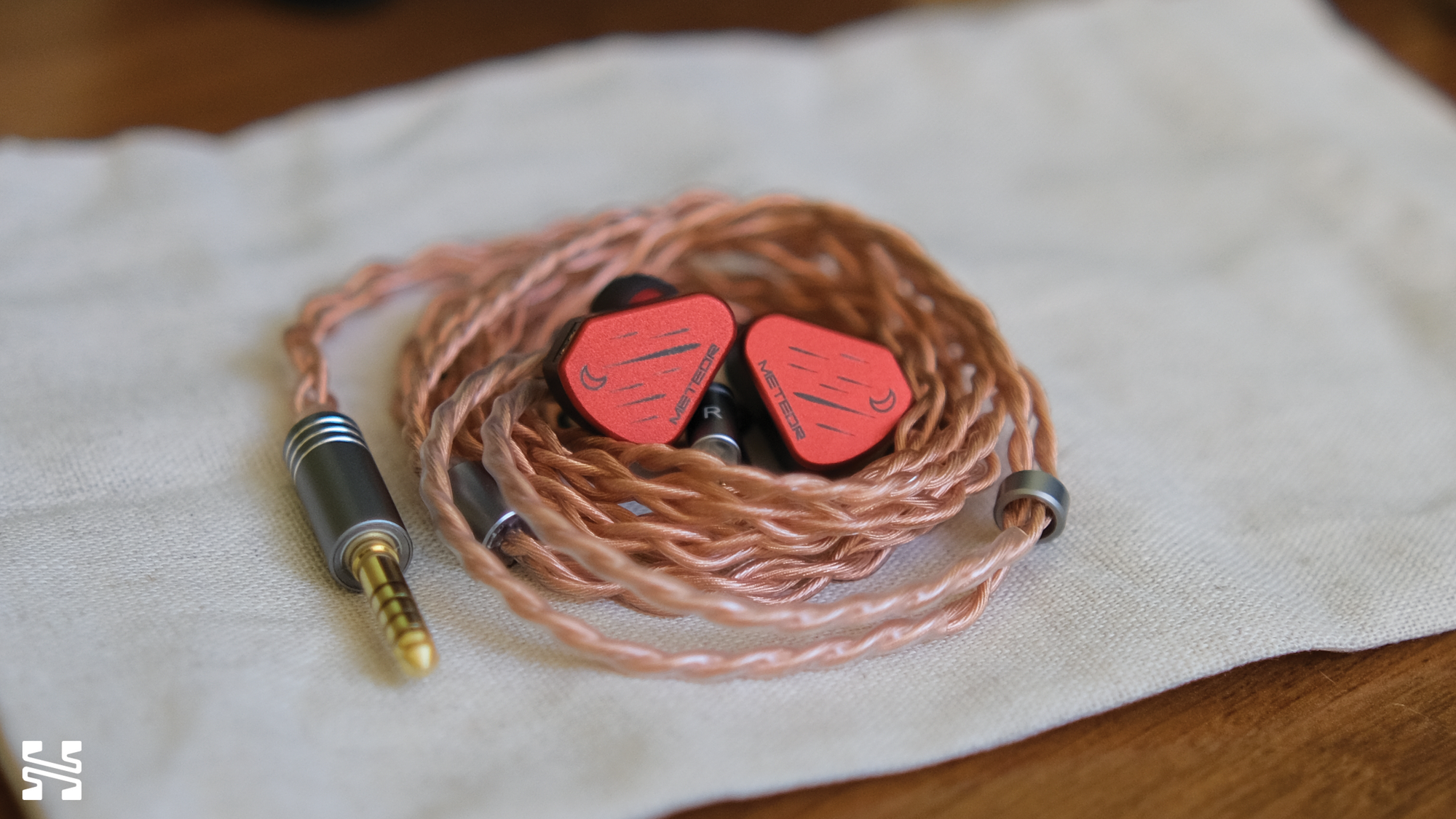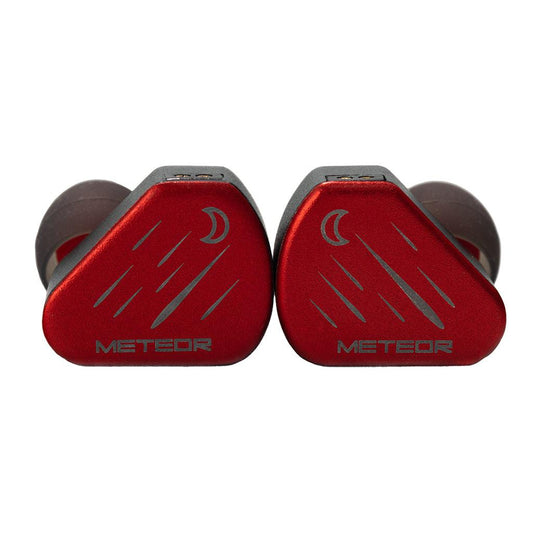Symphonium Meteor Review - The Spice of Sound

Introduction
Symphonium Audio made their mark with their flagship, the Helios, which was an IEM that challenged my notions of what was possible from a humble 4BA (balanced armature) driver setup. Consistent with the idea that less can be more, the brand has now released the Meteor ($600) which also utilizes a 4BA configuration. The Meteor promises small size and massive sound by taking advantage of Symphonium’s new PHAT technology. In a traditional BA IEM, BA drivers have individual tubes which carry segments of the frequency spectrum and congregate at the spout with multiple bores. Comparatively, the Meteor utilizes only a single tube to do it for its full-range drivers which results in less bulk. Of course, marketing and new technologies all come second to whether the Meteor delivers in terms of its actual sound, so let’s take a closer look.
Unit was provided for review by Symphonium Audio. As always, what follows are my honest thoughts and opinions to the best of my ability.
What we like
- Fantastic bass response and treble extension
- Unique, engaging presentation that is not often heard in this price territory
- Compact fit and solid assortment of accessories
What we don’t like
- Some tonal quirks as is common with U-shaped tunings
- Faceplate aesthetics could be improved
Source & Drivability
All critical listening was done off of an iBasso DX300 and my iPhone 13 Mini with lossless files. The stock silicone tips and cable were used. The Meteor takes a moderate amount of power to drive, but I had no issue hitting my usual listening volume of ~70dB on either device. If you would like to learn more about my listening methodology, then I would encourage you to check out this page.
In-the-Box

The Meteor’s packaging is cleverly integrated with a hard case that has a magnetic latch. It is a quality case with black fiber for the outside and a red microfiber lining inside. The additional accessories are found within:
- Symphonium silicone tips s/m/l
- Silicone tips s/m/l
- Foam tips s/m/l
- 2pin 0.78mm cable w/ choice of 3.5mm or 4.4mm termination
- Plastic carrying case w/ cleaning tool

Ergonomically, the Meteor reflects a lot of strides from its brethren, the Helios. While I love the sound of the Helios, I can’t deny that the large size is the main point of contention for prospective buyers. But basically, the Meteor reminds me of if someone hit the Helios with a shrink ray. It has the same amount of drivers at roughly half the size (fun fact: the Meteor’s entire driver module is about the same size as just the Helios’ two BA drivers for bass). Symphonium has also addressed the protruding connectors of the Helios with flush ones on the Meteor. All of this culminates in an easy-to-wear package that should fit even listeners with smaller ears. I certainly had no issues with fit or comfort.

The only real qualm I have with the Meteor is more of a vain one; it’s the aesthetics of the faceplate. The engraving is not the cleanest; in photos, you’ll observe that there is a slightly gritty amalgamation of black and gray to it. I think the quality of the engraving could be crisper, and I’m not sure if I’m sold on the moon and meteors graphic itself either.
Love our in-depth reviews?
We test and review hundreds of headphones every year. Sign up to get the latest news, reviews, guides, and more in your inbox. Join the 60,000+ like-minded audio lovers who love our newsletter!
Sound Analysis
“U-shaped” tuning is a tuning that implies boosted sub-bass and upper-treble. I have a special place in my heart for U-shaped IEMs given my long history with the 64A U12t. To date, the U12t remains - in my opinion - the best rendition of this type of tuning on the market. And for good reason: it’s an extremely difficult type of tuning to emulate. The sub-bass regions are difficult to boost cleanly and, up until a couple years ago, upper-treble extension was something considered foreign to most IEMs. And that’s not to mention even getting a good retention of this tuning. If there was anyone up to the task, then, perhaps it would be the folks at Symphonium Audio for which the Meteor is their foray.

The measurement above was taken using a clone IEC-711 coupler. There is a resonance peak at 8kHz. As such, measurements after this point should not be considered entirely accurate. If you’d like to compare the Meteor to other IEMs I have measured, please see this link.
The low end of the Meteor is best described as robust, thumpy, and heavily boosted in a good way. At its deepest point, it packs about 10dB of amplitude, and there is a generous thickness from 100-200 Hz as well. The Meteor’s bass, in many respects, illustrates how select manufacturers on the bleeding edge have been able to make “BA bass” and its negative implications a misnomer. Sure, I can say the Meteor’s bass falls short in the timbre department by still sounding slightly plasticky, as I think it does. But I have to recognize that’s mostly from a) the benefit of sighted knowledge (i.e. lack of vents on the shell), and b) from knowing that dynamic drivers generally do not have a bass curve like the Meteor’s. Ultimately, the Meteor puts on a pretty damn impressive show for bass given the tiny drivers it's packing.
The midrange of the Meteor is difficult to put my finger on for different reasons. It never quite sounds entirely wrong, but it does sport some minor quirks to it as most U-shaped IEMs do. In this instance, I would mostly point to a slight recession from 1-3kHz to the way the Meteor rises for its pinna compensation. This tends to steal some authority from male vocals and, indeed, that’s more or less what happens in this case. Granted, there is some warmth to counteract this from the Meteor’s thicker low-end, but the end result is a sort of plasticky effect to timbre. These issues are less evident within the context of the Meteor’s upper-midrange, but this would be expected given that my personal requisites for pinna gain are on the lower side and I listen to a lot of shouty tracks in the first place. In essence, the Meteor’s midrange might sound too muted, too thick for some listeners who are accustomed to indexing for clarity.
Now, the treble of the Meteor is interesting. It is slightly dipped in the lower-treble around 5-6kHz, again slightly recessed in the mid-treble, and then boosted strongly somewhere after, say, 14kHz. I won't say it sounds natural, as it can make certain recording artifacts pop in a sizzle-y manner and I'd prefer a hair more impact on snares. But for the most part, the execution here is good and this is a boon to my preferences as someone who craves upper-treble. Playing around with tips also usually proves fruitful with IEMs that have boosts like this. In any case, I'm fairly confident that there are not any IEMs at this price point that have their treble done like the Meteor does: that is, with this much pseudo-air, yet striking a (mostly) good balance.

For technicalities, the Meteor is not the most detailed IEM to my ears for $600, likely owing to the heavy bass boost and slightly recessed lower-treble. It’s certainly not to the point of which I would say it’s an issue for my standards, but it has to be noted when comparing the Meteor to top-dog competition like the Moondrop Variations. What the Meteor does have going for it is its imaging. It is surprisingly open sounding and notes have a pleasant palatableness to them on the stage. These sentiments can be partially attributed to the minor scoop from 1-3kHz and the contrast between frequencies in the treble. The Meteor is also a fairly punchy IEM for a sense of macro-dynamics, owing to its extra dash of mid-bass and boosted upper-treble.
Assessment of Value

No point in beating around the bush when it comes to the competition; I might as well stack the Meteor against the Moondrop Variations again. It’s clear to me that the Variations generally has an edge for technicalities in A/B, at least for a sense of detail. I think the Variations would also be considered the better all-rounder in general. But I’d be remiss to note that I don’t actually listen to my Variations very much. It’s a ‘vanilla’ sounding IEM, if you will, that’s been refined to a high degree, and I only use it for comparisons. By contrast, I think there’s a strong argument for the fun sound of the Meteor appealing to listeners (such as myself) who don’t enjoy that type of sterile tuning as much. Indeed, each time I get in a listening session on the Meteor, I have to admit that most IEMs like the Variations sound boring for a while before my ears acclimate again. Comparatively, something like the DUNU SA6 Ultra might be considered the middle ground between these two IEMs.

The Bottom Line
I’ve said a lot of good things, and some bad things, about the Meteor. But ultimately, I think that a lot of my nitpicks are just that…nitpicks. Even more likely, a product of there being so few good renditions of U-shaped tuning on the market in the first place. And I think that’s exactly what the Meteor is: it’s a good, perhaps even great rendition, of this more fun, unusual style of tuning. It’s not going to be for everyone, but it’s right up my alley and I think it’s worth giving a listen.
